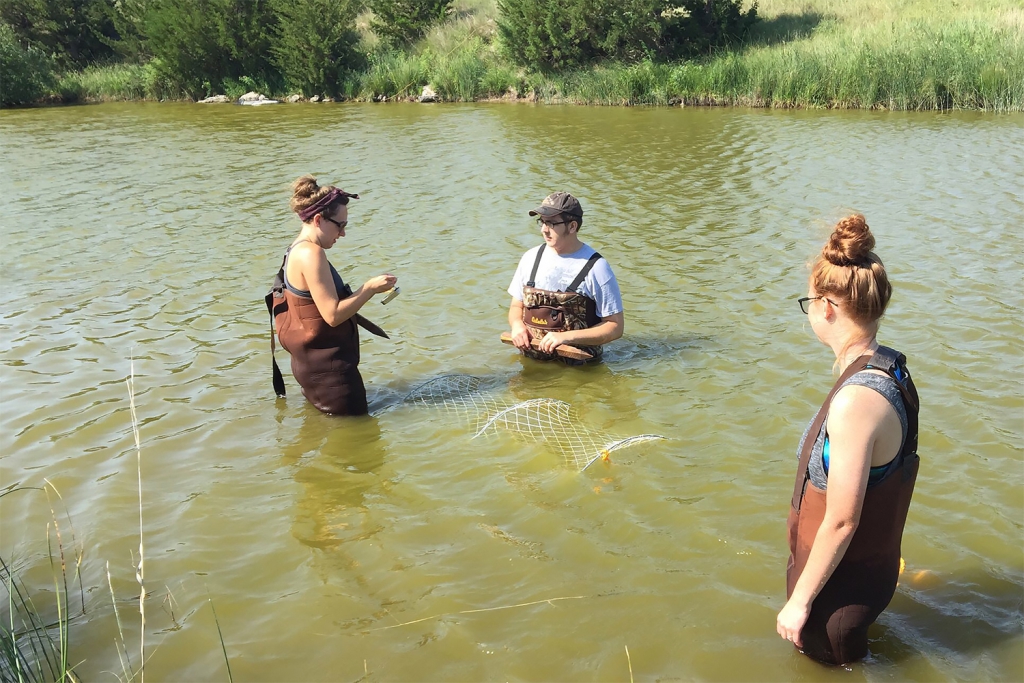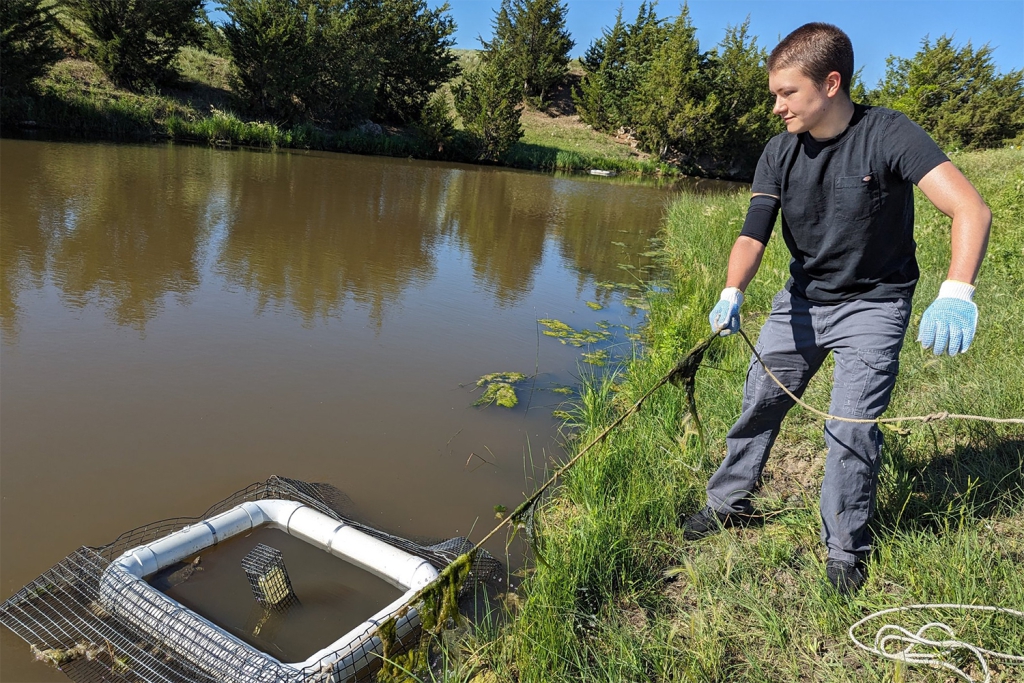Scott Schrage, July 6, 2023
Undergrad-driven project reveals drought’s effects on painted turtles
STUDIES FIND DROUGHT MAY LOWER SURVIVAL, SKEW FEMALE-MALE RATIO
A projected rise in droughts could muddy the waters for painted turtles and some fellow freshwater-dwelling reptiles, says 11 years of data collected by 50-plus undergraduates from the University of Nebraska–Lincoln.
Two recent studies based on the data suggest that drought can lower the survival odds, slow the growth and even skew the ratio of female-to-male painted turtles inhabiting the ponds of the Cornhusker State. Those outcomes emerged despite the water level of a sampled pond in southwestern Nebraska remaining relatively steady throughout the observed periods of drought.
“I have to admit: When the students launched into it, I wasn’t sure that we were going to find drought impacts,” said Larkin Powell, a professor in the School of Natural Resources who oversaw the studies. “I think it’s interesting that we found the drought impacts that we did, just given the fact that this is not a pond that completely dried up.”

Nebraska students Ellen Dolph (left), Tristan Powell (center) and Charrissa Neil adjust the bait for a hoop net used to capture painted turtles.
Like many other reptile and fish species, the sex of painted turtle offspring depends on the average ambient temperature during a stage of egg incubation. Whereas eggs incubated at lower temperatures tend to produce male painted turtles, temperatures above a certain threshold generally yield females.
Given that drought usually corresponds with higher temperatures, a warming-linked increase in drier conditions could potentially tilt the balance of female and male painted turtles. Husker alumnae Ellen Dolph and Charrissa Neil found that, in the absence of drought, males composed roughly 60-85% of the painted turtle sample. Nearly 60% of that sample instead hatched as female in the years when temperature, groundwater conditions and other variables indicated the greatest influence of drought.
Prior research has suggested that an extreme shift toward female-dominated ecosystems — the sort more likely to arise amid the hotter, drier climes expected in coming decades — could pose an existential threat to turtles and other reptile species. For the painted turtle, which inhabits much of North America and faces no short-term risk of extinction, that threat is less pressing, Powell said. But other, vulnerable species that share much in common with the painted turtle might wind up bearing more of the immediate brunt.

“There’s nothing crazily unique about a painted turtle compared to the other turtles — Blanding’s turtles, mud turtles, map turtles — that live in rivers and lakes,” he said.
For the first time, Powell and alumna Allyson Beard also showed that drought can lower the likelihood of survival in an intact pond — by roughly 7% in female painted turtles and 10% in males. And one of the team’s models suggested that, in future climate scenarios, every 10% increase in the likelihood of drought could correspond with a drop in annual survival rate.
By calculating changes in the length of shells, Dolph and Neil further discovered that the painted turtles, particularly females, grew slower in years of drought. That matters, Powell said, partly because the size of a shell can impose real constraints on a female’s ability to reproduce.
“Females grow faster than males,” he said, “and one of the reasons that they are selected to grow faster is that they can’t reproduce until they have enough space inside their shell to hold the eggs.”
Though the team isn’t sure exactly which drought-related factors might account for the reduced survival rate, Powell said the parallel slowing of growth points to the possibility of the turtles encountering more competition for less food, especially insects.
Turtle Powell
As an ecologist whose research career has gone mostly to the birds — prairie chickens, wild turkeys, Canada geese, thrushes, woodpeckers and the like — Powell hardly counted himself a turtle expert when, in 2005, he first headed for the Husker field site known as Cedar Point Biological Station.
There, amid 900-plus acres of prairie bordered by the Nebraska Sandhills, Powell was tasked with heading up a summer undergrad course on wildlife management techniques. One of those techniques: catching and marking specimens of a given species for the sake of estimating its population size. But arriving at a valid estimate would entail capturing specimens across multiple days, comparing the proportion of marked versus unmarked animals, then applying some theory-backed math. Catching his beloved birds, Powell knew, would prove too difficult and time-consuming to yield a large enough sample for that math to work its magic.
So he turned to the painted turtle, one of the most common species in Nebraska and, thanks to their slow-and-steady nature, “a perfect study animal.” After consulting with a local landowner, he located a pond near Keystone, Nebraska, that was brimming with shelled specimens.
“I normally do use birds for my population studies,” he said. “But it was hard to stop working with painted turtles, because they are so easy to capture.
“This has been me pretending to be a herpetologist for a week every year.”
Powell and his students usually catch the turtles with square traps that consist of a wire basket framed by empty PVC pipe buoyant enough to float. By the time the turtles have grown to the size that they can’t escape through the wire — typically around 5 or 6 years old — they often spend hours a day basking in the sun. The floating contraptions offer just the place and, when the turtles have soaked up sufficient sun, the possibility of going from basking to basket.

Will Hernandez, a junior in environmental science, reels in a PVC-framed turtle trap.
To distinguish one turtle from another, the students drill varying numbers of small holes into each turtle’s perimeter scutes: the island-like plates that grant both protection and pattern to the top of a shell. Powell would also later introduce injectable identification tags of the kind used to monitor cats and dogs.
In 2007, Powell taught the undergrad course at Cedar Point for his second and final time. The next summer, he decided to return anyway, again with turtle-seeking students in tow. Before he knew it, he’d been at it for more than a decade and counting. The handful or so of students who accompany him each summer, Powell said, seem to appreciate the chance to get their feet wet.
“Students complain that even entry-level jobs seem like they want you to have experience,” he said. “So we try to give that to them. Usually, the students who go with me haven’t done a summer research project before.
“It’s three or four days that a student, if they have no wildlife experience, can go out and get a little bit to put on their résumé.”
Eventually, Dolph, Neil and Beard, then-undergrads with theses to write before graduating from the University Honors Program, would avail themselves of the data their predecessors had collected in tandem with the turtles.
Powell said he hopes the trio’s findings might guide conservation plans, possibly by pinpointing when it would make sense to tweak pond conditions in favor of enticing more prey and sustaining painted turtles in leaner, drier years. More broadly, the drought-related survival odds and sex ratios could inform models used to estimate the probability that species will go extinct over a given time span. Those models, in turn, often steer decision-making about whether and when to captively breed species on the precipice of extinction.
“It took us a while to figure out what we could actually do with data that was of consequence enough to write a paper about,” he said. “But they turned out to be pretty important papers, I think.
“When I posted this on Facebook: A lot of those former students are out there, and I think they enjoyed seeing that Powell finally did something with this data, too.”





